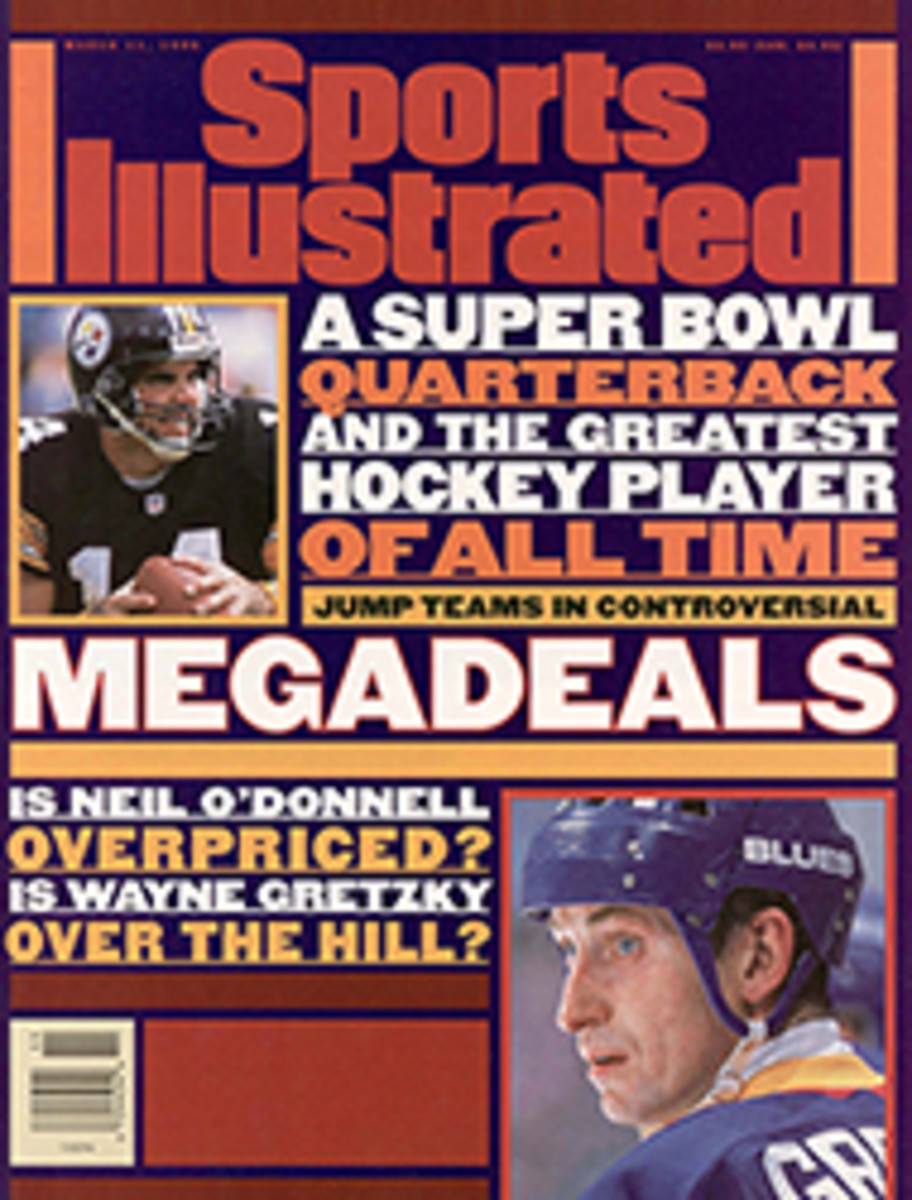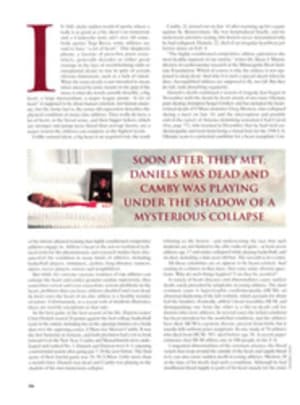
TEES PRODUCING THE GAME'S MOST HUMBLE TOOL IS A MATTER OF PRIDE, AND GREAT SECRECY
The mission: get the top brass at Pride Manufacturing, the
country's largest maker of golf tees, to talk. It wasn't going
to be easy. Located somewhere west of Bangor, Maine, Pride was
turning out to be as difficult to locate as Salman Rushdie, and
its executives as forthcoming as Greta Garbo.
Reporter in New York: "So how many tees do you actually make in
a year?"
Pride plant manager in Maine: "Well, I can't say exactly."
Reporter: "You mean you're not sure?"
Plant manager: "Nope, I mean I can't say. It's secret."
Secret? Would a leak to the press revealing the number of tees
produced in the U.S. undermine national security? We were
talking about golf tees, weren't we? Not the Pentagon Papers,
not the location of the White House bomb shelter, not even an
Oliver Stone movie, just those little sticks of wood that often
come packaged 12 for a buck and are used for everything from
holding up golf balls to removing mud from spikes to, yes, even
cleaning teeth. Bob Pride, the family-owned company's
fourth-generation president, tried to explain the company's need
for secrecy. "We just like to be low-profile," he said. "We
prefer not to talk about it, just to do it."
In the spirit of just doing it, here's what Pride Manufacturing
does, even though Bob Pride wouldn't tell us: It is the largest
manufacturer of golf tees in the U.S., with a worldwide
distribution of close to a half billion tees a year. What you
will learn in this story directly from Pride Manufacturing is
this: how and when the company first started making golf tees;
how many sizes, as well as colors, their tees come in; and how
the wood is milled (but not how it's shaped--"It's a secret,"
says Bob Pride).
When Scott Tilton, the head of Pride's sales and marketing
department, says the plant is impossible to find without
directions, he is wrong. It is impossible to find with
directions. Somehow this does not seem surprising. Four feet of
snow, a windchill of -35 degrees and a narrow winding road along
which most of the signs read ATTENTION! MOOSE CROSSING NEXT FIVE
MILES aren't making the search any easier. After passing a Mac's
Market and a thrift shop that, in this part of the world, could
double as a town, it seems prudent to stop and ask for help. In
answer to the question of whether Burnham, where Pride's largest
manufacturing plant is located, has already been passed, an old
Down-Easter, stacking cordwood by the side of the road, answers,
"Yup. Ya must've blinked, I guess." Sure enough, there is a
deserted-looking yellow-and-green warehouse sitting so quietly
in a field about a quarter mile back that you would think it was
actually holding its breath. The only sign, posted on the front
door, reads ANYONE ENTERING THE MILL DURING NON-PRODUCTION HOURS
OR ON A HOLIDAY MUST SIGN IN. ANY QUESTIONS MAY BE DIRECTED TO
THE SUPERVISOR.
In this case all questions are directed to Pride and Tilton,
who, it turns out, are not so much paranoid as protective, in an
intensely territorial way, about their product. What they
say--although none too convincingly--is that they are protecting
their clients. When asked who those clients are, Pride answers,
"Well, we talked about saying who, but we just don't want to
offend anyone by leaving them out." The issue, really, is that
Bob Pride just doesn't want to give away any information he
doesn't have to. Pride Manufacturing is one of only a handful of
companies in the U.S. that together produce some 700 million
tees annually, but the fact is the golf tee business is not
exactly a gold mine. It comes as no surprise, then, that Pride
jealously guards the financial stake his company has in the
market. Of his competition he simply says, "We prefer not to say
who they are."
When Pride Manufacturing was formed in 1930 by Bob Pride's
great-grandfather, Fletcher, it made wooden cigar tips. The
Pride factory was originally located in Tampa, hence the name of
the company to which Pride sells cigar tips: Have-a-Tampa. In
1957, flushed with success, Gene Pride, Fletcher's son, decided
to expand into the golf tee market and moved the operation to
Maine to be closer to the white birch and rock maple from which
both his tips and his tees are made.
Today tens of thousands of tees are manufactured each day at the
200,000-square-foot Burnham plant (there are also smaller plants
in Guilford, Maine; Florence, Wis.; and Brandon, Fla.). Logs are
received daily from throughout New England and cut by a sawmill
into sticks four feet long, 1/2-inch high by 1/2-inch wide.
Placed on pallets and kiln-dried for several weeks, the sticks
are then cut by band saws into smaller dowels about six inches
long and 1/2 inch in diameter. These, in turn, are fed into a
turning lathe from which the final product--a golf tee--emerges.
Five days a week the plant thrums with the sounds of band saws,
some as long as 34 feet. A dozen or so bins, weighing more than
300 pounds each and overflowing with brightly colored, white and
natural wood tees, create a kind of obstacle course on the
factory floor. When asked how many tees are actually in each
bin, Pride says, almost apologetically, "Well, we really prefer
to sidestep that question."
Oddly enough the simple, unglamorous golf tee has proved to be a
source of endless entrepreneurial inspiration over the years.
After the first patent for a tee, on a model made from paper and
shaped like a cone, was filed in 1896, manufacturers began
trying new and different materials from which to build a better
tee. These have included everything from sterling silver to
brass and bronze to rolled-up waxed paper. There have even been
edible tees, as well as ones that decompose in a matter of days.
Pride Manufacturing produces neither of these last two
variations. Pride makes wooden tees that come in nine different
lengths, from 1 3/8 inches to 4 1/2 inches, with 2 1/8 inches
being the standard. They also come in some 20 different colors,
including pink and orange neon (a hit in the 1980s), with white
being the most popular year in and year out. Tilton claims,
however, that natural wood may overtake white this year. "People
are always sending us drawings of the next great tee," he says,
"but in general most people like to stay with the basics."
Tilton is more than just a sales manager; he is a zealot for
whom golf tees are clearly an obsession. "I've gone to a golf
tournament or two with binoculars," he says, "and watched the
Tour players to see if they were using our tees. Most of them
were." Last November, Tilton was in Scotland for a trade show
and stopped by St. Andrews--not to play, but to walk the Old
Course and scour the ancient links for used tees. His
collection, which he proudly displays, consists of nearly 100
dirty, chipped, broken tees. Tilton sees only their beauty,
announcing proudly: "Seventy-five, maybe 80 percent are ours!"
The Pride Manufacturing execs clearly want you to love golf tees
too--though not if you're going to ask too many questions. Just
so there are no hard feelings, a gift box of natural wood tees
and a three-inch "tee pen" inscribed with the saying WOOD IS
GOOD are proffered at departure. One last question. Reporter:
"Why is there not even a sign out front with the company's name
on it?"
Tilton: "Oh, there is. It's just that it's on the ground, buried
under all the snow."
Right. Low profile.
COLOR PHOTO: PHOTOGRAPHS BY KEVIN BENNETT Every day is a tee party at the Pride plant in Maine, which churns out a half billion tees annually. [Man putting shovel into bin filled with golf tees]
COLOR PHOTO: PHOTOGRAPHS BY KEVIN BENNETT Tilton's prized collection comes from the home of golf. [Scott Tilton holding golf tees]

